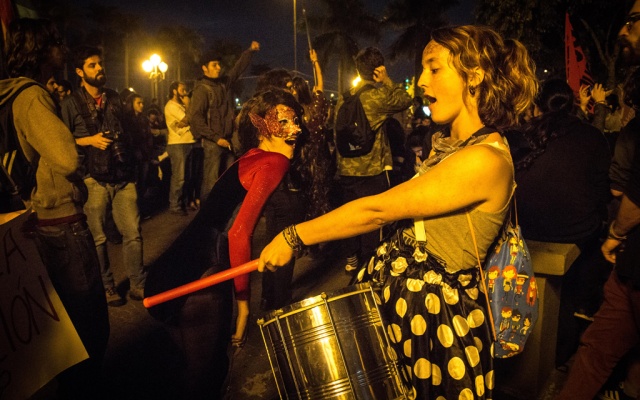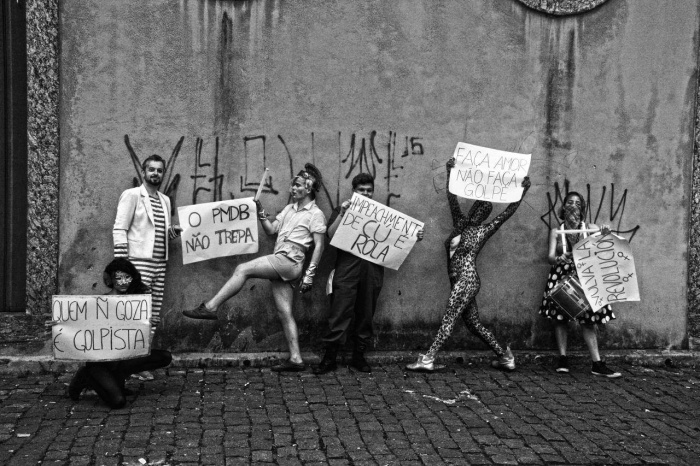
Wszystkie zdjęcia w tekście za uprzejmością grupy aktywistów i performerów „Blok brokatowy”. Dokumentacja z protestów 2016 roku w mieście Florianópolis w Brazylii. Fotografia: Fabio Salvatti
I would like to start this text by identifying myself as a Brazilian citizen, an arts teacher and an artist. I have been working with performance and human rights for more than a decade and I consider myself to be aligned with the thinking of left-wing parties. My professional activities at the university as well as my artistic practices are related and guided by a deep interest in the political realm of arts. Therefore, the invitation to write for Obieg about the new face of the political manifestations in Brazil stirred up the memories I bring from these events, mixing them with artistic experiences and theories about performance. It is within this triad that I intend to base the following text.
I have taken part in recent political demonstrations in Brazil in three decisive moments: in June 2013, when there was a fight for better social conditions instead of bringing the World Cup to Rio de Janeiro; between 2015 and the beginning of 2016, during the movement for President Dilma Rousseff’s removal; and after the rise of Michel Temer to the presidency in May 2016 – these last two are still taking place even today. Comparing these three moments, one could say that the protests have become lighter and more humorous throughout the three instances, going from the most violent in 2013 to the lightest and most fun in recent times.
The pressure that burst in 2013 made the street demonstrations manifest themselves in a very hard and violent way, with a high presence of Black Bloc groups, stores and public buildings being smashed and people being hurt, both by the protesters and the police. People from the lower strata of society made up the majority in these demonstrations. On the other hand, the 2015/2016 movement of the so-called “paneleiros” (pan-hitters) that pushed for the impeachment of (now) ex-President Dilma Rousseff, took a totally different shape, in terms of social strata (mostly made up of the upper middle class), political claims (all pushing for the same goal: Dilma’s resignation) and the protests’ shape (shorter duration, fewer people on the streets). At that time there was already an element of irony in the air, such as the use of satirical symbols – for instance, a yellow duck, baptized as the FIESP (this duck would become the symbol for the corruption in the Brazilian Federation of Industries, since we have a saying in Brazil that goes like “who is going to pay the duck?” which is used to ask who is going to be held responsible for something that goes terribly wrong), Fora Dilma’s choreographies, a humorous slogan “Tchau, querida” (“Bye bye, dear”) to express Dilma’s impeachment, and the collective act of hitting pans whenever Dilma Rousseff was on TV: on these occasions, one would hear the sound of pans being hit in the richest neighborhoods in all major cities in Brazil, but the direct violence and pressure had drastically decreased compared to the protests in the days of June and July 2013.
Meanwhile, the present protests seem to have diluted the violence even more radically, with their atmosphere being closer to a party, a celebration, a happy occupation of the street. It would be no exaggeration to link these characteristics to disbelief in political institutions – after all, they deposed a democratically elected President without evidence of her corruption. The sarcasm and jocularity of the current protests seem to reveal this disbelief, as well as a concern to keep the streets alive and free for the people, understanding that this new form of politics, less severe and more entertaining, may be more effective to the extent that direct and violent confrontation is replaced by a mood of celebration and festivity.
In addition, we see in protests nowadays a larger mix of citizens, coming from different social strata and searching for different goals: there are those who want direct elections (they use the hashtag #DiretasJá), others who only want the deposition of Michel Temer (#ForaTemer), a third wing wishing for the return of the Military Dictatorship (#DitaduraJa), another faction of people who long for the restoration of Dilma to the post of President (#VoltaDilma), and yet those who are “against everything and everyone” (#ForaTodos).
This multifaceted behavior can be understood in the light of Richard Schechner’s text “What is Performance?” taken from his book “Performance Studies: An Introduction” (2006). The American scholar fits the activities of public life – specifically citing carnival and collective political manifestations – as performances of the social body, pointing out that the multiplicity of agents and desires in the protests would characterize what the author calls “Actions for the Revolution” (2006, 4). Thus, a political situation would be characterized where participants resist, although they do not find common sense. In his words:
“The activities of public life – sometimes calm, sometimes tumultuous; sometimes visible, others masked – are collective performances. These activities range from sanctioned politics to popular demonstrations and other forms of protest, and even revolution. The agents of these actions intend to change things, maintain the state of things, or, more commonly, find or define an ordinary place. A revolution or a civil war happens when those involved do not give up and there is no common sense amongst them.” 1
During the post-Temer Manifestations, there is a double sense of this performativity cited by Schechner: a repetition of earlier social behaviors – perceived at the very beginning of the act of protesting, as it is today, as something already rooted in the political culture of several societies – and, on the other hand, a break in the seriousness and weight with which the protests were usually conducted, giving rise to atmospheres of humor and festivity.
This festive atmosphere has been accompanied by “socially liberated” behavior, typical of parties and which is also characteristic of these moments, temporarily suspending the “rules of an oppressive hierarchy.” These social performances carried out in the protests “are extraordinary moments marked by joy and values considered highly positive. While the routine of daily life is that it is seen as negative.”2
From this perspective, the introduction of social performance presents itself as a tool that provides a change in the life of an individual or social group, even before the right claimed is implemented. Hence, we notice the occurrence of what the Brazilian sociologist Rudá Ricci points out in his book “In the Streets” (2014) as “political carnivalization” a concept defined by the author as:
“An expression of popular utopia, separate from formal and institutional rituals. A carnivalized feast is an authorized transgression, which demeans the authorities, trivializes the established power and creates new identities. This potential registered in the Brazilian culture was updated in the June demonstrations. Posters, masks, dances, banners, t-shirts, stickers, banners, uniformed groupings, there was everything.”3
I have had for my own experiences with carnivalization, since I had the opportunity to participate in some demonstrations that took place in Belo Horizonte, capital of the mining state Minas Gerais, and also in the city of Viçosa, in the interior of Minas Gerais. In both cities, there were protests engendered in a modus operandi that used parties, frivolity, and humor as tactics to usher in non-violent modes of confrontation. These performances of the social body promoted instances of a political experience that were also – and above all – fueled by an aesthetic of irony, laughter, pleasure, and celebration.
Strange slogans, funny posters, and ridiculous activists play with serious protest, combining unusual characters such as clowns, fairies, cheerleaders, and LGBT to typical music and party elements such as drum kits, varied bands, choreographies, and flash mobs.
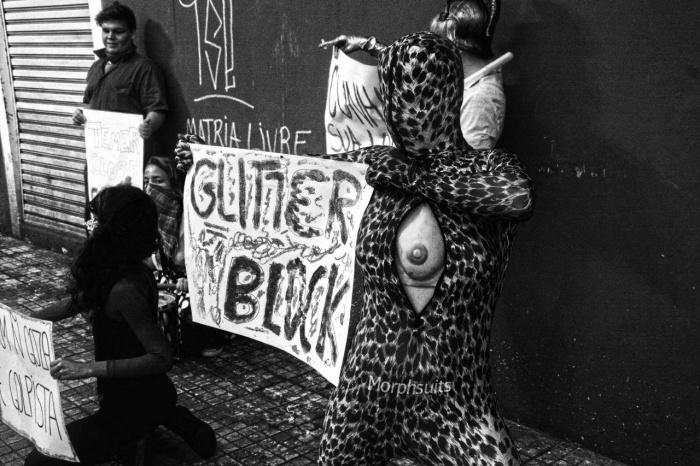
Wszystkie zdjęcia w tekście za uprzejmością grupy aktywistów i performerów „Blok brokatowy”. Dokumentacja z protestów 2016 roku w mieście Florianópolis w Brazylii. Fotografia: Fabio Salvatti
The performative aspect of manifestations of this kind have been baptized as “tactical frivolity” by the English sociologists and professors Graeme Chesters and Ian Welsh (2007), when the authors speak about an activism style called the “Pink and Silver Bloc”:
“Tactical frivolity is a form of public protest (...) often described as a space that exists in the distance between total fulfillment and violent confrontation. This strategy seeks to unravel confrontational tactics by multiplying front lines and making extremely ironic use of femininity and kitsch representations of the body in direct action. Music and dance provided this radical redefinition of street protest, not only with a powerful tool to virtually dissolve or deflect police violence. But also with the strongest possible image (and soundtrack) to realize how the street manifestations can become the triggering of the body’s desires at the moment of the protest itself.”4
As the name says, the Pink and Silver Bloc uses a set of colors to differentiate itself from other groups, such as the Black Bloc. Chesters and Welsh (2007) report that the Pink and Silver Bloc emerged from a movement called “Reclaim the Streets” (RTS) that held parties – or anti-capitalist direct actions – in cities such as London, Tel Aviv, Sydney, New York, and Helsinki in the 1990s.
Its characteristics can be compared to the protests carried out in post-Temer Brazil, since they both present traces of party, of collective delirium, street theatre, and political manifestation. They work by creating acts of resistance that are powerful poetic gestures and effective political strategies. These political street festivities reclaim urban space, hitherto used as a mesh for capitalism, consumerism, and private transport, replacing them with autonomous temporary zones: living and vibrant spaces previously forbidden to pedestrians.
The poetic and irreverent character of these manifestations distances them from the ineffective strategies of socialist and leftist groups whose flags and logos are predominantly red. They usually act with live music, rather than electronic sound, dress idiosyncratically and are improvised, often customizing their clothes right there with spray and stencils available. They carry posters that satirize phrases that have appeared in the manifestations.
Rudá Ricci (2014) recounts:
“The posters and demands were made right there on the streets, in the squares where the swarm was gathering for walks and protests that clouded the country.”5
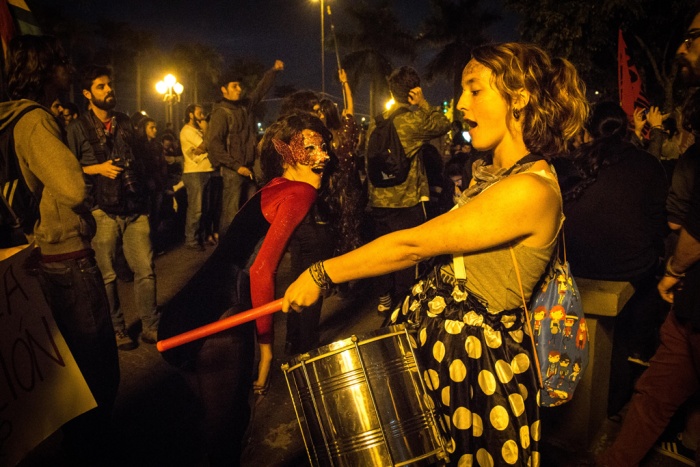
Wszystkie zdjęcia w tekście za uprzejmością grupy aktywistów i performerów „Blok brokatowy”. Dokumentacja z protestów 2016 roku w mieście Florianópolis w Brazylii. Fotografia: Fabio Salvatti
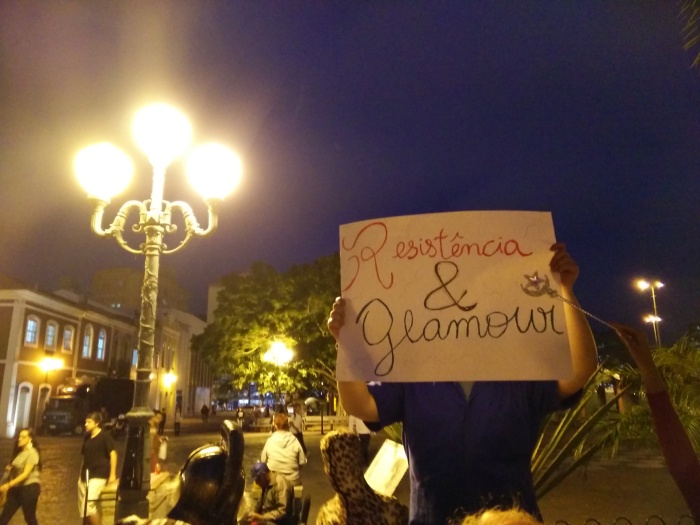
Wszystkie zdjęcia w tekście za uprzejmością grupy aktywistów i performerów „Blok brokatowy”. Dokumentacja z protestów 2016 roku w mieście Florianópolis w Brazylii. Fotografia: Fabio Salvatti
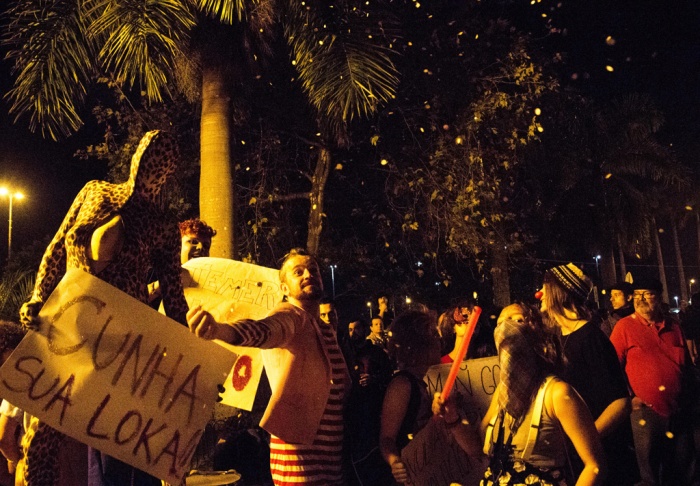
Wszystkie zdjęcia w tekście za uprzejmością grupy aktywistów i performerów „Blok brokatowy”. Dokumentacja z protestów 2016 roku w mieście Florianópolis w Brazylii. Fotografia: Fabio Salvatti
Music, poetry, and irreverence connected a sea of different people. All of it was registered under collaborative coverage, created with mobile phones in hand. The material produced in these portable media, scattered throughout the crowd, eventually ends up at social networks, fueling a web of “meta-performances” of the social body. The repetition of street images, so often focused on violence, on these occasions was diverted to a sense of party, laughter, and derision.
Far from the domination of the ruling classes and within an economy of political carnivalization, the effect produced by the flow of these images in the networks, circulating and re-feeding the organization of the movement, acted outside and independently of the conventional system. In a setting of cultural effervescence, the circulation of these poetic images, so often unpolished, gives the viewer a sense of hyper-consciousness.
The images that circulated were produced by the very entrails of the movement, in rhizomatic structures of this social body, not from the outside inwards. These images are forms of empowerment of the movement, precisely because they are not imputed by the ruling classes nor controlled by the conventional media, but created by the crowd itself. Brazilian philosopher Kátia Silvestri studies carnivalization as the political organization of a multitude of subjects who transgress power relations. She argues that carnivalization is the practice of reversing, shifting, turning the world upside down. It would then be understood as a way of finding transgression: carnivalized confrontations. The author locates in the popular manifestations that are circulated (circularity proper to the tension between official and daily ideology) by society, the very signs of resistance that disarticulate relations of domination.
Thus, we rely on this thesis to understand carnivalization not only in the stylistic plane of the protests – written and visual support – but also as an ethical reach into its aesthetic dimension, as lived experiences, as a production of everyday ideology.
More precisely, Silvestri points us to the need “to understand that the logic of carnivalization is the logic of the reverse, of the grotesque – an alternative practice to centralizing and institutionalized discourses and, thus, an inalienable centrifugation of creation and human will.”6 The author goes on to discuss the theories of carnivalization7 and multitude,8 problematizing discourses about power relations, identities and the ethical-responsive actions, elaborating a cut in the analysis that proposes links between the carnivalization and multitude of singular subjects.
According to Silvestri, in Bakhtin, to read reality means to problematize the ideological clashes produced by respondent subjects. In this way, carnivalization as the insurrection of everyday life is a policy whose project is to dismantle official ideological discourses, de-structuring identities and relations of domination. To this the author adds Negri and Hardt’s concept of the multitude: this union of singularities that in the name of a common realm – the desire to unbalance oppressive practices – transgress, reverse, displace, and reframe power relations in various ways (such as parties, protests, folklores, books, movies, blogs among others) and express themselves as grotesque bodies that are the basis of the carnival action.
It is the notion of singularity that opposes the notion of identity (fixed, cohesive, and solidly constituted), which does not allow the concept of multitude to be confused with that of mass. For Negri and Hardt, multitude is the double, the reverse of a capitalistic subjectivation in mass formats. That is, the multitude of singularities terrorizes, destabilizes, and challenges hierarchical structures of domination. The same occurs in the carnavalization, for Bakhtin: these popular manifestations carry with them an inversion value, a destructive principle of the discourses, and as said, also the deconstruction of identities and relations of domination.
Thus, in addition to aligning concepts like carnivalization and multitude, we again propose that we compare these images of tactical frivolity to what Guy Debord advocated in 1967:
“It is not only by its economic hegemony that the society that carries the show dominates the underdeveloped regions. It dominates them as society of the spectacle. Where the material base is still absent, modern society has already spectacularly invaded the social surface of each continent. It offers local revolutionaries the false models of revolution. The very spectacle of bureaucratic power held by some of the industrial countries is precisely part of the total spectacle, such as its general pseudonyms and its support. If the spectacle, viewed in its various locations, shows totalitarian specializations of the word and of social administration, they are merged in a global division of spectacular tasks into the global functioning of the system.”9
The images by “Glitter Bloc,” a Brazilian activism performance group lead by artist Fabio Salvatti, exemplify how political manifestations of tactical frivolity aim to combat all this bureaucratization of the very way of protesting. As a conclusion, we can say that the carnivalized manifestations in post-Temer Brazil generated, through laughter and pleasure, a new political energy, which, like popular celebrations, carries with it something transgressor: in the momentary gap which opens in these experiences, it is as if life changes course. This is the critical utopian impulse of carnivalization and, also, this is where its political resilience raises.
BIO
Christina Fornaciari is an artist and an arts teacher (Federal University of Viçosa), based in Belo Horizonte and Viçosa, Brazil. She works in the interface between performance, installation, and photography, with exhibitions nationally and abroad, in countries such as China, Mexico, the UK, and Italy. Her research mixes autobiography, politics, and technology. She holds an MA in Performance by Queen Mary University of London (UK) and a PhD in Performance by Federal University of Bahia (Brazil). Site: http://cargocollective.com/christinafornaciari
1 Richard Schechner, Performance Studies: a critical introduction, Routledge, London 2006, p. 3.
2 Roberto Damatta, Carnavais, malandros e heróis. 6ª ed., Rocco, Rio de Janeiro 1997, p. 99.
3 Rudá Ricci, Patrick Arley, Na Rua, Letramento, Belo Horizonte 2014, p. 34.
4 Graeme Chesters, Ian Welsh, Complexity and Social Movements: Protest at the Edge of Chaos, Routledge London; New York 2006, p. 15.
5 Rudá Ricci, Patrick Arley, Na Rua, op. cit., p. 56.
6 Katia Vanessa Tarantini Silvestri, Carnavalização como transgrediência da multidão, 2014, p. 23.
7 Michael Bakhtin, A Cultura popular na idade média e no renascimento: o contexto de François Rabelais, Hucitec, São Paulo 2010.
Michael Bakhtin, Estética da criação verbal. Martins Fontes, São Paulo 2006.
8 Michael Hardt, Antônio Negri, Multidão. Guerra e democracia na era do Império. Record, Rio de Janeiro 2004.
9 Guy Debord, A sociedade do espetáculo. Paris. 1967. Electronic version http:// www.ebooksbrasil.org/adobeebook/socespetaculo.pdf accessed in 08/08/2017, p. 42-43.



